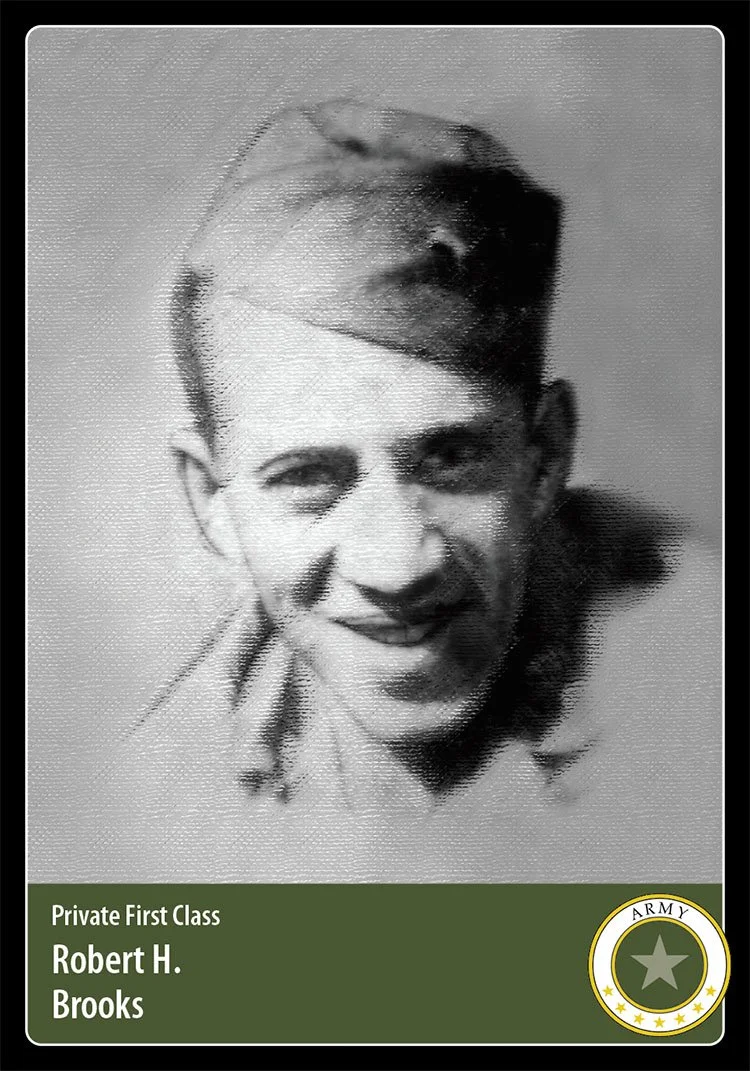Hero Card 106, Card Pack 9
Artist’s rendering by Craig Du Mez
Hometown: Sadieville, KY
Branch: U.S. Army
Unit: D Company, 192nd Tank Battalion
Date of Sacrifice: December 8, 1941 - KIA at Clark Field, Luzon, Philippines
Age: 26
Conflict: World War II, 1939-1945
Born on October 8, 1915, Robert H. Brooks was raised in the small town of Sadieville, Kentucky, along with his two sisters. His parents, Ray and Adeline Brooks were sharecroppers. As an adult, Robert moved 60 miles north to Cincinnati, Ohio.
In late 1940, Brooks joined the U.S. Army and was sent to Fort Knox, Kentucky for training as a tank and half-track driver with D Company, 192nd Tank Battalion.
In October 1941, Brooks’ company loaded onto trains bound for San Francisco. In early November they boarded ships and headed across the Pacific. After stops in Honolulu and the island of Guam, they reached their destination: Clark Airfield on Luzon Island in the Philippines.
On December 7, 1941, the airmen and soldiers at Clark Airfield received news by radio about the Japanese surprise attack on Pearl Harbor, Hawaii. As the National World War II Museum explains:
As Adolf Hitler’s armies rampaged across Europe, overrunning Germany’s neighbors in 1939-40 and threatening to invade the British Isles, the European colonial empires in Asia lay nearly undefended, ripe for the picking: the Malay Peninsula, the Dutch East Indies, Indochina. Rich sources of raw materials lay in all of them, rubber, tin, and especially oil, the precious lifeblood of any modern economy.
The following day, December 8, 1941, the Japanese launched an air attack on the Philippines and Clark Airfield. Private Robert H. Brooks was killed instantly by a Japanese bomb. He was 26 years old. Brooks had been in the Philippines just one day and was the first Armored Force Soldier killed in World War II.
When news of Brooks’ death reached Commanding General Jacob Devers at Fort Knox, he ordered that the main parade ground be named in honor of Pvt. Brooks.
But Robert Brooks had kept a secret that was not revealed until after his death. At a time of racial segregation in the U.S. military, Brooks kept his race a secret to serve in an all-white tank battalion. In 1940, most black Americans were not allowed to serve in combat roles and were given menial duties in the military.
The Army had no idea that Robert Brooks was black until his parents arrived for his funeral. Brooks was light-skinned and didn’t correct the draft board official who had incorrectly listed him as white.
On December 23, 1941, Brooks’ parents attended a ceremony dedicating the main parade ground at Kentucky’s Fort Knox base “Brooks Field.” General Jacob Devers, Chief of the Armored Forces, gave an address: “In death, there is no grade or rank. And in this, the greatest democracy the world has ever known, neither riches nor poverty, neither creed nor race, draws a line of demarcation in this hour of national crisis.”
Sources
Artist’s rendering by Craig Du Mez
U.S. Army: Fort Knox parade field honors heroic battlefield actions of WWII Black tank Soldier
Time Magazine: The Forgotten Story of One of the First U.S. Soldiers Killed Overseas After Pearl Harbor
Bataan Project: Brooks, Pvt. Robert H.
The News-Enterprise: Black Army private left a legacy behind
Historical Marker Database: Robert H. Brooks (1915-1941)
Burial Site: Find a Grave





